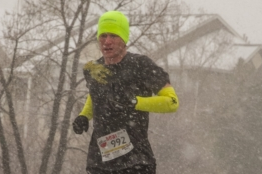Picking a spring race is challenging given that winter training tends to have more weather-related interruptions.
We had a couple of decent-sized snowstorms in the past few weeks. Often in our area, snow is followed by sun and we’re quickly back to our running routines. Frigid weather came on the heels of these storms. Our sidewalks and trails still have residual snow and ice pack along them. While running the other night, looking at my watch brought consistent frustration as my per-mile pace was below what I prefer. I then reminded myself that I was dodging and slowing down frequently for snow and ice patches.
This is not to dissuade anyone from aiming for a spring race. Rather, it’s to point out that there could be a number of factors that impact your training and that if you do choose a significant spring race, to roll with them.
If you’re training for a marathon and an impending snowstorm is forecast to collide with your long run, consider moving it up a day. It’s not likely to clobber your schedule (though you do want to consult the plan you’ve chosen) and you can still get the run in. You can have a similar approach for shorter race preparation if you had a key speed workout that would fall on a snow day.
If you’re uncomfortable switching the day, consider a shorter route that you can repeat near your house. One contingency plan I made for the virtual marathon this past fall was that if the weather had been crummy, I would run loops in my neighborhood so I could switch out socks and clothes quickly if needed. Or, if you feel that being close to your home would make it too tempting to call it off early, consider carrying an extra dry hat and other clothes in a small backpack or drawstring bag. It can feel burdensome but the times I’ve used one in snowy conditions, when I needed dry gear, I had it.
When you’re training in wintry conditions, it’s likely that your pace will be slower. That’s something of a “duh” statement but it’s important to keep in mind, which can reduce the frustration. Also, you’re still logging the miles and if you’re training for a longer distance, you may be on your feet longer which can help you on race day.
There are benefits to winter training, too. Slogging it out through some nasty stuff between December and March will give your mental fortitude a boost. Some people enjoy having running paths and trails to themselves and on nasty weather days, far fewer runners are out on them.
If you’re going for a key spring race, it’s often a good time of year as the weather is likely to be decent and it serves as a reward after months of winter training. It just requires a little physical and mental flexibility.

Running anecdotes, running food reviews, some race coverage, and more